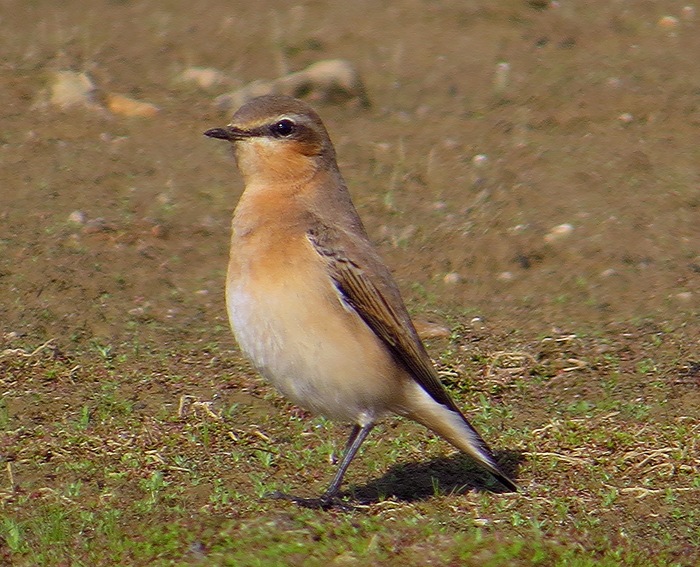The week remained unsettled with periodic showers and mid/late-week night-time temperatures down to around 3ºC, the lowest since before the summer. Although predominantly westerly, the wind in the latter part of the week shifted between gentle northerly to mild southerly. Wader numbers crept up and included some autumn ‘firsts’ at a couple of local reservoirs.
In addition to the long-staying Great White Egret at Pitsford Res, two new birds appeared this week – one strutting around the shallows at the eastern end of Sulby Res on 16th and another on the main lake at Stanwick GP on 20th.

Fly-over Ospreys were seen on 17th at Bulwick and the following day at White Mills Marina (Earls Barton GP), while the only other notable raptor was a ‘ringtail’ Hen Harrier, which was seen on and off throughout the day at Stanford Res – also on 17th.

Wader passage picked up during the period, with numbers of Ringed Plovers (twenty-three on 19th and twenty-four on 21st) at Pitsford approaching those of the ‘old days’, while the same site continued to hold a Black-tailed Godwit on 16th-17th, another visited Stanford Res on 20th and seven were there on 22nd. Pitsford – still offering the best wetland birding by miles – continued to provide the main wader focus, with a Turnstone there on 19th and the autumn’s first Little Stint on 18th-19th, rising to two there on 20th-21st.


Two Little Stints were also found at Hollowell Res on 19th, where last week’s Grey Phalarope continued to perform until 17th, the last date on which Pitsford’s juvenile Spotted Redshank was also seen.


The 17th also signalled time up for last week’s Arctic Tern at Stanford, which had moved on by the following day. A first-winter Little Gull visited Daventry CP on 22nd, just one Mediterranean Gull, a first-winter at Stanwick GP, was seen on 21st, while the only Yellow-legged Gulls were single adults at Cransley Res on 16th and at Pitsford Res on 21st, with four at both Pitsford and Daventry CP on 17th and 20th respectively and two again at Daventry CP on 22nd. This week’s duo of Caspian Gulls comprised what seems destined to become a regular adult at Naseby Res on 16th and 21st and a first-winter at Daventry CP on 20th.

It’s normally October before we encounter the first of the autumn’s Short-eared Owls but this week there were two: one at Hollowell Res on 16th and the other at Harrington AF the following day.

Only the third reported in the county this year, a female Pied Flycatcher was trapped and ringed at Southwick on 22nd. This species appears to have succeeded in evading county listers in 2017! Still more Common Redstarts came through, with one at Harrington AF on 16th-17th and singles in the Brampton Valley on 20th and 22nd, while three sites produced Whinchats, including one at Stanford Res and two at Stanwick GP on 18th and two in the Brampton Valley on 20th.


Stonechats can either be quite scarce or we can sometimes have a bumper winter but with the first ones arriving, or just passing through, locally we can only speculate. Two were at Pitsford Res on 16th, singles were at Stanford Res on 18th and 20th and at Sywell CP on 21st, while two were in the Brampton Valley on 20th and 22nd.

This autumn is, so far, proving extremely poor for migrant Northern Wheatears and the trend continues this week with just two seen: one was at Hollowell Res from 17th to 21st and another was found in the Brampton Valley on 20th, this locality also producing a fly-over Tree Pipit on 22nd.











 I quickly made my way to the point and, after putting the news out, started to watch and video it, keeping a safe distance so as not to disturb it. I needn’t have bothered. I was soon joined by Cathy Ryden and we were then dismayed to witness a crew of noisy young rowers cruising alarmingly close to the phalarope, at which point it was spooked and promptly vanished. Fortunately, Cathy relocated it later in the afternoon and it remained on site until at least mid-morning today.
I quickly made my way to the point and, after putting the news out, started to watch and video it, keeping a safe distance so as not to disturb it. I needn’t have bothered. I was soon joined by Cathy Ryden and we were then dismayed to witness a crew of noisy young rowers cruising alarmingly close to the phalarope, at which point it was spooked and promptly vanished. Fortunately, Cathy relocated it later in the afternoon and it remained on site until at least mid-morning today.







 Wednesday 13th September. In the wake of Storm Aileen it was difficult to believe no displaced seabirds would have occurred in Northants. On cue, then, a juvenile Sabine’s Gull arrived at Daventry Country Park at 16.30 and was picked up straight away by Gary Pullan as it circled the northern end of the reservoir.
Wednesday 13th September. In the wake of Storm Aileen it was difficult to believe no displaced seabirds would have occurred in Northants. On cue, then, a juvenile Sabine’s Gull arrived at Daventry Country Park at 16.30 and was picked up straight away by Gary Pullan as it circled the northern end of the reservoir.


















 Stanford Res enjoyed a run of Common Redstarts, with two trapped and ringed on 26th, another trapped and ringed on 28th, followed by one there on 29th. Singles were also seen at Borough Hill on 26th and at Fawsley Park the following day, while two were found in a hedgerow near Twywell on 1st.
Stanford Res enjoyed a run of Common Redstarts, with two trapped and ringed on 26th, another trapped and ringed on 28th, followed by one there on 29th. Singles were also seen at Borough Hill on 26th and at Fawsley Park the following day, while two were found in a hedgerow near Twywell on 1st.
